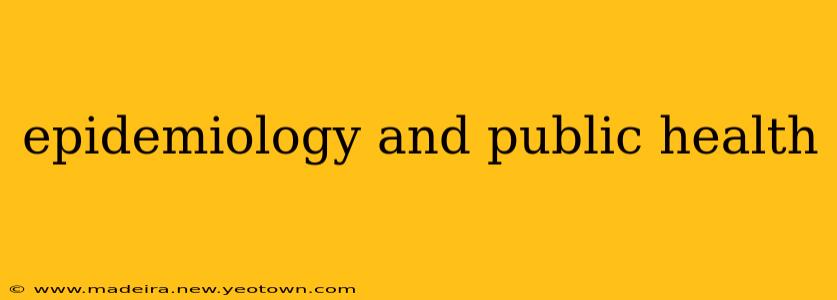The world holds its breath when a new virus emerges, a strange illness spreads, or an unexpected spike in a chronic disease occurs. This is where epidemiology and public health step in, working hand-in-hand to unravel the mysteries of disease and protect the well-being of communities. But what exactly are these fields, and how do they differ? Let's embark on a journey to understand their interwoven roles.
Imagine a detective meticulously piecing together clues at a crime scene. That's essentially what epidemiologists do, except their "crime scene" is a community experiencing an outbreak or unusual health pattern. Epidemiology is the study of the distribution and determinants of health-related states or events in specified populations, and the application of this study to the control of health problems. It's about asking the "who," "what," "when," "where," and "why" of disease. They use statistical methods to analyze data, identify risk factors, and track the spread of illness. Their work is crucial in understanding why diseases occur and how they can be prevented.
Public health, on the other hand, is a broader field encompassing all efforts to promote, protect, and improve the health of populations. It’s a collaborative effort involving researchers, policymakers, healthcare professionals, and community members. While epidemiology provides the scientific foundation for understanding disease patterns, public health implements strategies to prevent disease and improve the overall health of the population. Think of it as the application of epidemiological findings to create real-world impact.
What is the difference between epidemiology and biostatistics?
This is a common question, and the difference lies in the application of statistical methods. Biostatistics is the application of statistical methods to biological and health-related data. Epidemiologists use biostatistical methods extensively in their analyses, but their focus is always on understanding and controlling health problems within populations. Biostatisticians, on the other hand, may work on a broader range of biological data, not necessarily focused on health outcomes in populations. They provide the statistical tools, while epidemiologists utilize those tools to answer questions about disease.
What are the main branches of epidemiology?
Epidemiology is a diverse field with several key branches:
-
Descriptive Epidemiology: This branch focuses on describing the distribution of disease—who gets sick, where they live, and when they get sick. Think of this as the initial investigation, laying the groundwork for further analysis.
-
Analytical Epidemiology: This goes beyond description and seeks to identify the causes of disease. It uses various study designs, such as cohort studies and case-control studies, to explore potential risk factors and causal relationships.
-
Infectious Disease Epidemiology: This branch specializes in tracking and controlling the spread of infectious diseases, like influenza or COVID-19. This involves surveillance, outbreak investigation, and the implementation of control measures.
-
Chronic Disease Epidemiology: This focuses on understanding and preventing chronic diseases like heart disease, cancer, and diabetes. This requires long-term studies and investigations into lifestyle factors and environmental exposures.
How does epidemiology relate to public health?
Epidemiology forms the bedrock of public health. The findings from epidemiological studies inform public health interventions. For instance, an epidemiological study demonstrating a link between smoking and lung cancer led to public health campaigns promoting smoking cessation. Similarly, epidemiological surveillance of infectious diseases allows public health officials to predict outbreaks and implement timely interventions like vaccinations or quarantine measures. It's a dynamic partnership where one informs and guides the other.
What are some examples of epidemiology in action?
Epidemiology isn't a theoretical field; its impact is seen daily. Here are a few examples:
-
Tracking the spread of COVID-19: Epidemiologists played a crucial role in understanding the transmission dynamics of the virus, informing public health responses like lockdowns, mask mandates, and vaccine development.
-
Identifying risk factors for heart disease: Epidemiological studies have revealed risk factors like high blood pressure, high cholesterol, and smoking, leading to public health initiatives focused on promoting healthy lifestyles.
-
Investigating outbreaks of foodborne illness: When a foodborne illness outbreak occurs, epidemiologists work to identify the source of contamination and prevent further spread, often through meticulous tracing of food sources and consumer habits.
Epidemiology and public health are essential for safeguarding community well-being. They are dynamic fields constantly evolving to meet the challenges of emerging diseases and chronic health issues. By understanding disease patterns and risk factors, we can develop and implement effective strategies to prevent illness, improve health outcomes, and build healthier communities.

